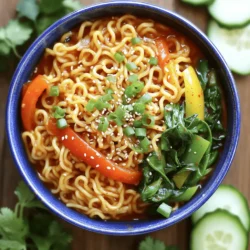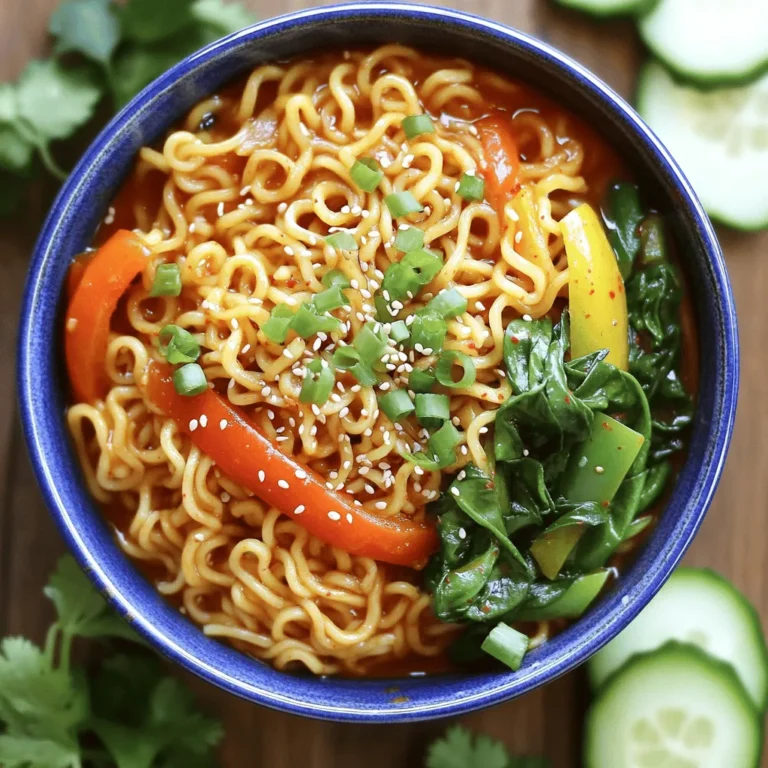If you crave a dish packed with flavor but easy enough for any home cook, Korean Gochujang Noodles are your answer. These spicy, savory noodles are quick to make and require simple ingredients you might already have. In this guide, I’ll show you how to whip up a delicious bowl and even share tips on adjusting the spice level. Let’s dive into this tasty adventure!
Ingredients
Essential Ingredients for Korean Gochujang Noodles
To make Korean gochujang noodles, you need simple yet key items. Here’s what you’ll need:
– 200g noodles (choose from udon, soba, or rice noodles)
– 2 tablespoons gochujang (Korean chili paste)
– 1 tablespoon sesame oil
– 1 tablespoon soy sauce
– 1 tablespoon honey or maple syrup
– 2 cloves garlic, minced
– 1 teaspoon fresh ginger, grated
– 1 cup bell peppers, thinly sliced (a vibrant mix of red, yellow, and green)
– 1 cup baby spinach leaves
– 2 green onions, sliced (green and white parts)
– 1 tablespoon sesame seeds, toasted
– Optional: thinly sliced cucumber and fresh cilantro for garnish
These ingredients create a tasty blend of flavors. The gochujang gives a spicy kick, while honey adds a touch of sweetness.
Summary of Substitutions
You can swap some ingredients based on what you have. Here are a few ideas:
– Noodles: Use any noodle you like. Rice noodles are gluten-free.
– Gochujang: If you can’t find gochujang, try sriracha or another chili paste. It won’t taste the same but will still be spicy.
– Vegetables: Feel free to use other veggies like carrots or snap peas.
– Sweetener: If you don’t have honey, agave syrup or sugar works too.
These swaps keep the dish fun and fresh.
Recommended Brands for Gochujang and Noodles
When choosing products, quality matters. Here are some brands I trust:
– Gochujang: Look for brands like Chung Jung One or Sunchang. They offer rich flavor and good heat.
– Noodles: For udon, try Hakubaku. For soba, I like the brand King Soba. If you want rice noodles, check out Thai Kitchen.
These brands provide flavors that shine in your dish.
Step-by-Step Instructions
How to Cook the Noodles Perfectly
To cook the noodles, fill a large pot with water. Add some salt for flavor. Bring the water to a vigorous boil. Once it boils, add the noodles of your choice. Cook them according to the package instructions. You want them al dente, so don’t overcook. When they are ready, drain the noodles in a colander. Rinse them under cold water. This stops the cooking process and keeps them from getting mushy.
Making the Gochujang Sauce
In a medium bowl, mix the gochujang, sesame oil, soy sauce, and honey (or maple syrup). Whisk these together until smooth. Next, add the minced garlic and grated ginger. Stir until everything is combined well. This sauce gives your noodles a rich, spicy flavor. Set the sauce aside for later.
Sautéing the Vegetables for Optimal Flavor
Grab a large skillet or wok and heat it over medium-high heat. Add a splash of vegetable oil to the pan. When the oil is hot, toss in the thinly sliced bell peppers. Sauté them for 3-4 minutes. You want them to be soft but still crunchy. After that, add the baby spinach. Stir for about 1 minute until it wilts. This step adds color and freshness to your dish.
Now, you are ready to combine everything!
Tips & Tricks
Best Practices for Stir-Frying Noodles
Stir-frying noodles is quick and fun. Here are some steps to follow:
– Use High Heat: Keep your skillet or wok hot. This helps the noodles cook fast.
– Don’t Overcrowd: Stir-fry in small batches. This way, everything cooks evenly.
– Prep Ahead: Have all your ingredients ready before you start cooking. This keeps the flow smooth.
– Use Oil Wisely: Add just enough oil to prevent sticking. Too much can make the dish greasy.
How to Adjust the Spice Level
You can make your gochujang noodles milder or spicier based on your taste. Here are some ideas:
– Less Gochujang: Start with one tablespoon instead of two. You can add more later if needed.
– Add Sweetness: Mix in honey or maple syrup to balance the heat.
– Dairy Help: Serve with a dollop of sour cream or yogurt. This cools down the spice.
– Use Vegetables: Add more veggies like cucumbers or bell peppers. They help tone down the heat.
Making the Recipe Ahead of Time
You can prep your gochujang noodles in advance. Here’s how:
– Cook Noodles: Follow the cooking steps but stop before adding sauce. Rinse and store them in the fridge.
– Make Sauce: Prepare the gochujang sauce and keep it in a sealed jar. It lasts about a week in the fridge.
– Store Veggies: Cut your bell peppers and green onions. Store them in airtight bags.
– Combine Later: When ready to eat, reheat the noodles and veggies. Add the sauce for a quick meal.

Variations
Vegetarian Options for Korean Gochujang Noodles
If you want a vegetarian twist, you can swap out meat for veggies. Use mushrooms, zucchini, or carrots to add texture and flavor. You can also add tofu, which absorbs the sauce well. Firm tofu works best, as it holds its shape. Just cube it and sauté until golden. This makes a hearty meal without any meat.
Protein Add-ins: Tofu, Chicken, or Beef
Adding protein can make these noodles more filling. If you like tofu, use the method above. For chicken, slice it thin and sauté until it’s cooked through. Beef can also be a great choice. Use thin strips of flank steak and cook it until brown. Both meats take on the gochujang flavor well. Just remember to adjust the cooking time based on the protein you choose.
Gluten-Free Alternatives for Noodles
If you’re gluten-free, don’t worry! You can use rice noodles or gluten-free pasta. Rice noodles are light and soak up the sauce nicely. Just cook them based on the package directions. If you prefer, look for gluten-free brands of udon or soba noodles, too. This way, everyone can enjoy these tasty gochujang noodles.
Storage Info
Proper Storage Techniques for Leftovers
To keep your Korean gochujang noodles fresh, store them in an airtight container. Make sure they cool down first. This helps prevent sogginess. You can keep them in the fridge for up to three days. If you plan to eat them later, it’s best to store the noodles and sauce separately. This way, the noodles won’t absorb too much sauce and become mushy.
Reheating Tips for the Best Flavor
When it’s time to enjoy your leftovers, reheating is key. You can use the microwave or a pan. If you choose the microwave, heat in short bursts. Stir between each burst to ensure even heating. If you use a pan, add a splash of water or broth to help steam the noodles. This keeps them moist and flavorful. Heat until warm but avoid overcooking.
Freezing the Noodles and Sauce
You can freeze the noodles and sauce if you want to save them for later. Place the noodles in a freezer-safe bag or container. Make sure to remove as much air as possible to prevent freezer burn. For the sauce, store it in a separate container. When you’re ready to eat, thaw them in the fridge overnight. Reheat them as described above for a quick, tasty meal.
FAQs
What is Gochujang and How is it Used?
Gochujang is a thick, red chili paste from Korea. It has a unique blend of heat, sweetness, and umami. You use it in many dishes, like stews, marinades, and, of course, noodles. It adds depth and flavor to meals. The paste is made from fermented soybeans, glutinous rice, and salt. This mix gives it a rich taste that enhances any dish.
Can I Make Korean Gochujang Noodles Without Noodles?
Yes, you can! If you want a noodle-free meal, use vegetables instead. Try zucchini noodles, cauliflower rice, or even sautéed mushrooms. These substitutes keep the dish tasty and light. Just follow the same steps for sauce and veggies. It’s a fun twist for those who want to skip the carbs.
How Do I Make Gochujang Noodles Less Spicy?
To tone down the heat, adjust the gochujang amount. Use only one tablespoon instead of two. You can also add more honey or maple syrup. This sweet balance will cut the spice. Incorporating more vegetables helps too. The added bell peppers and spinach can help cool the dish.
Korean Gochujang noodles offer delicious flavors with simple steps. You learned about key ingredients, cooking methods, and flavor tips. We discussed veggie options, protein choices, and safe storage. Making these noodles is easy and fun. Remember, the sauce can adjust spice, making it great for everyone. Enjoy your tasty creation. With practice, you’ll master this dish and impress your friends!


